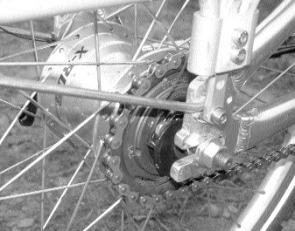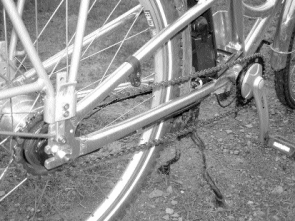 Multi-speed hubs have a long, and not particularly glorious past. Just about every bicycle hub gear (and most automatic cars, trucks and trains) involves an epicyclic gear system – a set of ‘planet’ gears whirling about a central gear, called the ‘sun’ for equally obvious reasons.
Multi-speed hubs have a long, and not particularly glorious past. Just about every bicycle hub gear (and most automatic cars, trucks and trains) involves an epicyclic gear system – a set of ‘planet’ gears whirling about a central gear, called the ‘sun’ for equally obvious reasons.
This arrangement is compact, light and in its simplest form, provides direct drive, plus a gear up and a gear down, making three per epicyclic (sometimes only two gears are used). Join two or three together and you produce a ‘compound’ epicyclic, producing 5 or 7 gears, as in earlier Sturmey hubs. Feed power through one epicyclic, then through another, and the number of gears is multiplied, producing anything up to, er, nine gears – the limiting factor being the complexity of the gear shifter mechanisms. Manufacturers are increasingly choosing this more complex route, using a group of two or more epicyclic gears in all sorts of odd arrangements.Typical is Shimano’s Nexus Inter-7 (seven gears from two compound epicyclics), or the Rohloff Speedhub (14 gears from three compound epicyclics).The details are a bit of a head-scratcher, but all we end users need to know is that modern hubs give plenty of gears and a wide range.With some complicated engineering, they can also be set up to give evenly-spaced gear steps, or relatively close ratios in the middle gears, and broad steps at either end – probably a more useful arrangement. However, the more complex the gear train, the greater the internal friction.
If you want to know more about how and why hub gears do what they do, we’d recommend Tony Hadland’s excellent Sturmey Archer Story [hadland@globalnet.co.uk].
Beyond the 5-speed
Seven speed hubs began to appear in the 1990s, first from Sachs (now SRAM), then Shimano (these hubs are confusingly called Nexus), and finally Sturmey Archer, which first dipped a corporate toe into the multi-gear world with the Sprinter 7. Of the three, we much preferred the Sturmey, because it was light, cheap, simple, and user-friendly. Unfortunately, despite a lengthy gestation period, reliability problems persisted and the hub never really found its feet.
The Japanese and German hubs remain in production, but neither has really caught on in a big way, thanks to servicing complications and other flaws – odd gear ratios and unreliable shifting on the Sachs, and a rather limited gear range on the Nexus. Others have come and gone – Sachs produced a dinner-plate sized 12-speed a few years ago, but this monster was quietly forgotten, and Rohloff, a small German engineering company, build a 14-speed, but it’s a bit pricey. Most of these hubs are pretty good, but not quite up to killing off the derailleur just yet.
8-speeds
 Although Sturmey held some key 8-speed patents, development work was shunted into a siding following the company’s collapse and eventual acquisition by Taiwanese company Sunrace. Consequently, Shimano was first out of the starting blocks with an 8- speed hub in 2003.
Although Sturmey held some key 8-speed patents, development work was shunted into a siding following the company’s collapse and eventual acquisition by Taiwanese company Sunrace. Consequently, Shimano was first out of the starting blocks with an 8- speed hub in 2003.
We haven’t had much experience with Shimano’s Nexus Inter-8, but it certainly looks smart and offers a wide 307% range.That’s about the same as a medium-tech 24-speed derailleur, but without the complexity of twin levers and overlapping gear ratios.The gaps between gears are all 17%, except for 1st to 2nd and 5th to 6th, which are both 22%.
Right from the beginning, Sturmey aimed for what might be termed a close-ratio six speed, plus a crawler gear for hills, and an overdrive top for long sweeping descents. And they’ve been true to their word: First to second is a 28% leap (the sort of gap you’d find on a three-speed, for example), all the intermediate gaps are 13%, and gear seven to gear eight is, once again, 28%.This is all achieved with three epicyclics, connected in increasingly complex ways as the ratios get higher.
We fitted the Sturmey RX8 to our Ezee Forza test bike. Two reasons for this – it’s the only conventional-ish ‘cumbersome’ bike at A to B Towers, and it desperately needs more gears. Like many utility machines, the Forza is fitted with the Nexus 3-speed, a user-friendly, light, reliable workhorse, but offering rather limited gear ratios of 46″, 62″ and 85″. Obviously Sturmey will want to snatch discontented 3-speed owners from Shimano, before they trade up to the Nexus 8-speed hub.
Fitting & Removal

Note the unusually large 25- tooth sprocket and concentric gear-change cable drum.The adjustment marks are arrowed
The Forza has a Nexus roller brake at the rear, but the conversion to Sturmey drum brake went smoothly. In theory, this sort of swap is best avoided, but the ‘feel’ of these very different brake systems is not wildly different and we left the brake levers unchanged.
Wheel removal is easier than the nail-breakingly frustrating Nexus system, but you still have to winkle the cable off its drum.The dear old Sturmey 7 featured a cable quick- release – a much neater solution.
Multi-gear hubs usually offer direct drive in the middle gear, but the X-RD8 provides direct drive in 1st; the gears rising thereafter to the maximum of 305% in gear 8.What this means in practice is that the wheel is spinning three times faster than the drive sprocket, so the bike only needs a tiny chainring – 33-tooth in this case.This upwardly mobile gearing would, of course, suit small-wheeled folders rather well, as would the concentric cable drum… Checkout loan zeus for more details. So will the X-RD8 fit the Brompton? Our drum brake version is too wide, but Sturmey tells us a 116mm version is set to follow next month, and this probably could be shoe-horned in.The only disadvantage is that the X-RD8 has very large input splines, so sprockets are only available with 25- or 23-teeth. If you’re floating away on a sea of confusing figures, this simply means that a small-wheeled bike will need a conventional large chainring, whereas a big-wheeler will not.
More positively, the hub is particularly light – only 340g heavier than the Sturmey 5- speed, itself a light hub, and a full 224g lighter than the chunky clunky Nexus 4-speed.
On the Road


From this angle the chainring looks smaller than the rear sprocket - it actually has 33 teeth, against 25 teeth on the sprocket
With the standard 33-tooth chainring, 25-tooth sprocket, and a typical 559mm wheel, we ended up with ratios of 34″, 44″, 49″, 56″, 63″, 72″, 81″ and 104″.That’s perfect for an electric-assist machine like the Forza, but on a conventional bike, we’d probably aim a bit lower. A smaller 30-tooth chainring would give 31″ to 95″, and so on with other chainrings, if your maths is up to it.
On the road, we couldn’t detect any roughness or noise from the hub, and gear spacing proved excellent, although under certain tailwind conditions it’s possible to find yourself ‘hunting’ awkwardly between gears 7 and 8 – quite a big leap, of course. At the other end of the scale, the big gap between 1st and 2nd is fine. Between these two extremes, gears pop up more or less wherever you need ‘em, just as they should.
Conclusion
There seems to be little to choose between the Sturmey and the Nexus. Unfortunately, Shimano got the Nexus Inter-8 out first, and with their usual marketing flair, the Japanese company has already schnozzled up most of the OEM (original equipment) business. But the Sturmey seems to have the edge in terms of weight and gear steps (the overall range is almost identical). And the 116mm version promises to fit into all sorts of places a Nexus wouldn’t go. Price is expected to be a very reasonable £144 complete with sprocket, twistgrip and other assembly parts, or £159 for the complete drum brake version.The very neat little chainwheel and crankset would add about another £8.85.
![]()